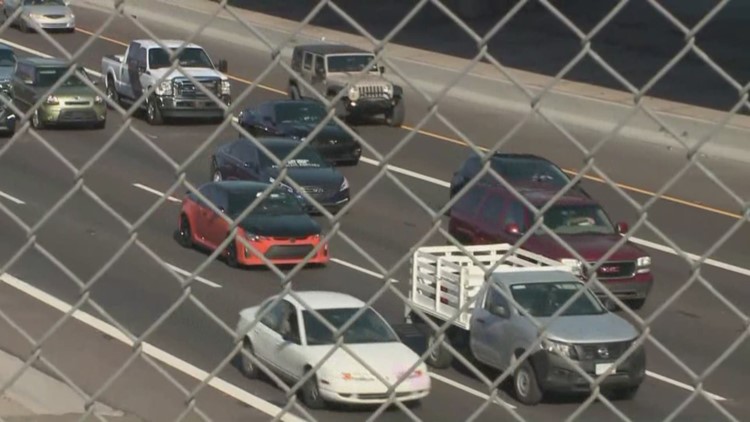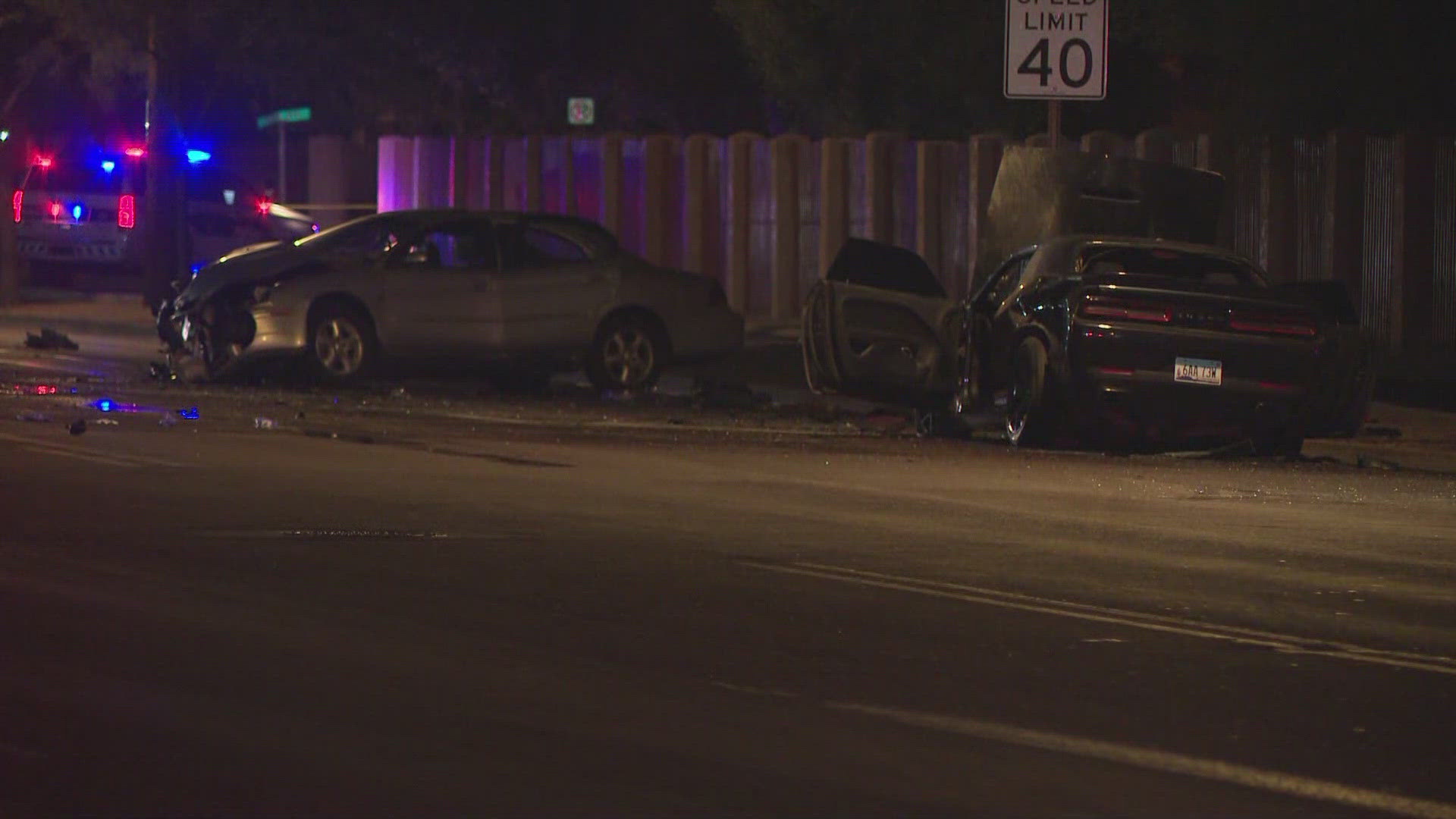PHOENIX — In less than 24 hours, 13 cars were involved in three separate crashes at 35th Avenue and Thomas Road in west Phoenix. Car debris littered the sidewalk where multiple people were injured, including a young girl.
In Tucson, a truck hit an adult pushing an infant in a stroller, ultimately killing the baby and injuring the adult. The driver is facing charges of manslaughter, aggravated DUI and aggravated assault.
Phoenix and Tucson are in the top 10 cities for the most dangerous drivers. Arizona is the 15th worst state for drunk driving, according to data from Forbes Advisor.
Stacey Champion, a Phoenix-based community activist for road safety, was filming a video about the dangers of middle reverse lanes when she saw a woman get off the bus and narrowly avoid being hit by four cars. Her experience is highlighted in 'The Street Project,' a documentary about how dangerous roadways are across America.
But why are Arizona roadways so dangerous?
'Dangerous by design'
The 50 most populated cities were compared based on five factors to determine which cities had the most dangerous drivers, according to a data analysis by Forbes Advisor. Tucson was listed as number four and Phoenix as number eight.
Tucson scored 93.02 out of 100 and ranked fourth highest in total number of fatal car crashes and fourth highest in the number of people killed in crashes. The southern Arizona city also has a large number of crashes that involve speeding, and drunk and distracted drivers. Phoenix scored 80.65 out of 100 and also had a large amount of crashes involving speeding.
This data wasn't surprising to Champion. She lives near an intersection where she frequently sees drivers speeding and running red lights. Champion created a petition to eliminate Phoenix's reverse lanes in 2023 — but she said there needs to be more done.
"The way that our streets are designed, they're designed for speed," Champion said. "The problem with people traveling — especially kind of urban cores and through neighborhoods — at these highway speeds, is that whether you, or another driver or somebody's that not in a vehicle, the chances of you dying — not just being injured, but dying — are going to increase."
Joseph Catone is a collision and traffic investigator and former Mesa police officer of over 20 years who worked as a vehicular crimes detective. Catone said during his time as an officer and in his work now, he heard from many of Arizona's "winter visitors" that roads are wider and maintained well, and speed limits are higher in Arizona than from where they live year-round. There also different traffic laws state to state.
"Sometimes we even heard from, even the regular residents... as well as your winter visitors, 'I just I didn't realize I was going that fast,' just because it makes it so easy," Catone said.
Champion grew up without a car and took public transit, walked or biked to get around. She has lived in Arizona for 25 years and said walking and biking in Arizona feels terrifying.
"As somebody who also felt like it was pretty safe to ride a bike as a kid and have some of those freedoms, I don't think that my kids have had that same pleasure," Champion said. "... the streets here are very dangerous by design."
Forbes analyzed 50 cities with the following five metrics, per 100,000 citizens, to calculate the scores.
- Number of fatal car crashes: 24% of score.
- Number of fatal car crashes involving a drunk driver: 19% of score.
- Number of fatal car crashes involving a distracted driver: 19% of score.
- Number of fatal car crashes involving speeding: 19% of score.
- Number of people killed in fatal crashes: 19% of score.
Fatal crash increase
There were 1,294 people killed and 52,411 people injured in crashes throughout 2022. The peak date for all crashes in 2022 was Feb. 23. There were 509 crashes on that day alone, according to the Crash Facts report from the Arizona Department of Transportation.
From 2021 to 2022, Arizona roads saw fewer crashes overall: in 2021, there were 121,506 crashes. In 2022, there were 119,991 crashes.
But the number of people who died increased by 8%. In 2022, there were 1,294 fatalities in vehicle crashes, which is 102 more fatalities than in 2021.
Champion said when she sees faded crosswalks and reverse lanes at rush hour, commonly referred to as "suicide lanes," she isn't surprised by the increase in deaths.
"It's no wonder we have people dying all over the city," Champion said. "The fact that we have something called the 'suicide lanes' that has become normalized is also appalling. That shouldn't be normal, and we shouldn't have streets that function like highways running through our neighborhoods. It's not safe for anybody. Nobody should be in that big of a hurry."
Arizona also has different environmental factors to consider, Catone said. Because the weather is warmer during the winter, motorcyclists are often riding in January and February. As a rider himself and from his work experience, Catone said the increase in riders can be a surprise for visitors from colder climates.
"(There's) probably not too many motorcycle riders in January (and) in February, but here that's prime riding season, right, because it's not 100 and hot," Catone said. "There needs to be an awareness both on drivers on the roadway, whether you're a winter visitor or a resident here permanently of Arizona, that motorcycle riders are going to be more abundant in the wintertime."
The latest data from the ADOT is from 2022. 12News requested the Crash Facts annual report from 2023 but was told the data would be released at a later date.
Safer streets
Catone has a lot of experience with traffic safety professionally, but also in another role: as a father of four children, all of whom are driving. Catone said he tells his sons to "drive with intent."
"That doesn't mean that you're like, trying to compete for a race compete for a lane or you know, you're not trying to beat anybody. That's not what this is," Catone said. "It's the idea that we're on the road and you're going from A to B even if it's an enjoyable ride... you need to get there, that's kind of goal one, you need to get where you're going."
Correcting driver behaviors is one way to keep drivers and pedestrians safe, as well as narrowing the roadways visually, Catone said. Cities and towns can put in bike lanes or designate street parking to narrow the path cars and vehicles travel on.
"That tends to force the drivers to slow down because now it feels like they just don't have as much room to maneuver," Catone said.
When people think of car crashes, they may think of speed or impairment as factors, but Champion said car crashes can also reveal equity issues. Natural ways to slow cars down, such as planting trees, or sidewalks and bike lanes are not in all neighborhoods.
"Go to any affluent neighborhood in the city, and you will see more trees. You will see more buffers, you will see, like, you will see more of these tools that make our streets nice that then you won't see in underserved communities," Champion said. "Our streets are for everyone. Whether you're in a car, whether you have to use a wheelchair, whether you are pushing a baby stroller, whether you are on a bicycle, we need streets that are safer for everyone."
People need to get involved at the local level to build safer streets, Champion said. There are plenty of ways to get involved, such as advocating at city or town council meetings and creating awareness in your own neighborhood, Champion said.
"Everything kind of starts in your own neighborhood, talking to your neighbors," Champion said. "There's power in numbers."
Want to learn more about road safety in Arizona? Check out these resources, initiatives and datasets for more information:
Deaths on Arizona roads
Data from the Arizona Department of Transportation shows that roadway fatalities have been gradually rising in Arizona over the last decade:
- 2011: 827 deaths
- 2012: 821 deaths
- 2013: 849 deaths
- 2014: 774 deaths
- 2015: 897 deaths
- 2016: 952 deaths
- 2017: 998 deaths
- 2018: 1,011 deaths
- 2019: 980 deaths
- 2020: 1,054 deaths
- 2021: 1,192 deaths
- 2022: 1,294 deaths
ADOT offers driving tips on its website to help keep people safe on the road.
"There’s always room for improvement when it comes to road safety," the department said on its website.
ADOT's suggestions include:
- Don’t speed or drive aggressively
- Never drive while under the influence of substances
- Avoid distractions while driving
- Wear your seatbelt and make sure all passengers are doing the same
- When an emergency vehicle is on the side of the road, move over
- Stay extra aware in work zones
- Be prepared for weather conditions that make driving dangerous
"Real-time highway conditions are available on ADOT’s Arizona Traveler Information site at az511.gov, by calling 511, downloading the AZ 511 app and through ADOT’s Twitter feed, @ArizonaDOT," the department said.
Up to Speed
Catch up on the latest news and stories on the 12News YouTube channel. Subscribe today.



